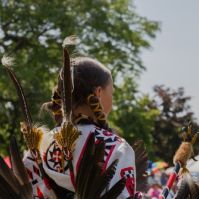 South Bend might be most known for its football program, but the city has a long industrial history. The factories built in the early 19th century were the driving force in immigration to the area. Catholics from Poland, Germany, Italy, Ireland and Hungary came to South Bend for the economic opportunities.
South Bend might be most known for its football program, but the city has a long industrial history. The factories built in the early 19th century were the driving force in immigration to the area. Catholics from Poland, Germany, Italy, Ireland and Hungary came to South Bend for the economic opportunities.
Notre Dame University
The university is probably the best-known feature in South Bend. The campus has more than 170 buildings, but the most recognizable is the Main Building with its gilded dome. The building was completed in 1879 and required over 300 skilled workers, including stonemasons and bricklayers. Due to a shortage of workers in the Chicago area, workers came to South Bend from long distances to complete the building. The golden dome was the last thing to be completed. It is crowned with a 19-foot tall statue of Mary and can be seen for miles around.
Notre Dame also has 57 chapels on campus, including the Basilica of the Sacred Heart, built in the Gothic Revival style in 1888. It has some lovely features, including a spire and bell tower. The World War I memorial door remembers 46 students, alumni and faculty who died in the war. It has 116 stained-glass windows made by French nuns.
On the side of the library that faces the stadium, make sure to look at the 134-foot high mural called “The Word of Life.” The main image in the mural is that of Jesus, with his arms raised high. It is that image that gave the mural its nickname “Touchdown Jesus,” but the mural isn’t about football. The other figures in the mural represent Christian teachers, thinkers and saints from different places and centuries, designed to convey the Catholic Church’s place in history.
The Grotto of Our Lady of Lourdes is a replica of the famed French shrine of the same name, albeit much smaller than the original. It was built in 1896, using boulders from the surrounding farms. It is a very special place on campus for students, designed to be a shrine where people could find calm and peace. However, on busy weekends, it can be difficult to find a candle to light, because so many people come to the shrine every day.
Today, Notre Dame maintains its architectural design throughout the campus by constructing buildings using locally sourced materials, much like it did in the past. However, the university is committed to being environmentally conscious. It’s a leader in innovative energy sustainability. If you ever have a chance to see the beautiful architecture on the campus, it’s worth exploring.
Former First Presbyterian Church
This church, the former home of the First Presbyterian Church, is a stunning example of Richardsonian Romanesque style. It’s made of fieldstone from local sources and is trimmed with limestone. It has a beautiful Palladian-style stained glass window and corner bell tower that gives it presence without the tall spire so often found in churches of the 19th century.
St. Paul’s Memorial Church
St. Paul’s is designed in the Gothic style, an expression of new life. The Studebaker family, who made wagons and cars, was instrumental in building this church, which was finished in 1901. Look closely at the stained-glass window that depicts Saint Paul preaching on a hill in Athens. Mr. Studebaker and his servant are two of the characters. Just recently, the congregation raised over half a million dollars to restore the original Bennett pipe organ, the largest in South Bend. It features 2,400 pipes that range from 16 feet to under one-half of an inch.
Saint Patrick Church
This church, known for beauty and elegance, is a historic landmark. The building was completed in 1887. The main altar is made of Carrara marble, which had to be quarried in Italy. The five stained-glass windows above the altar depict some of the most popular Catholic saints, including Ambrose, Augustine, Thomas Aquinas, Patrick, Joseph and Brigid.



